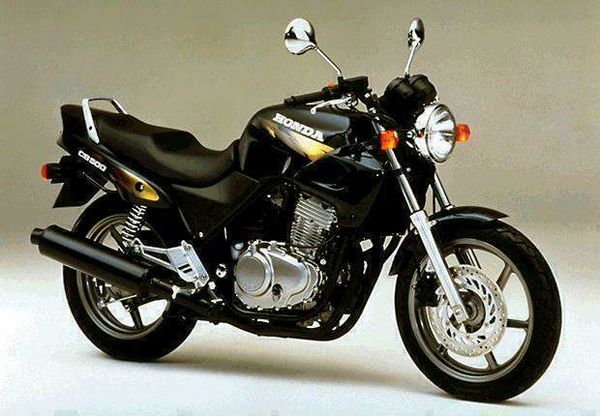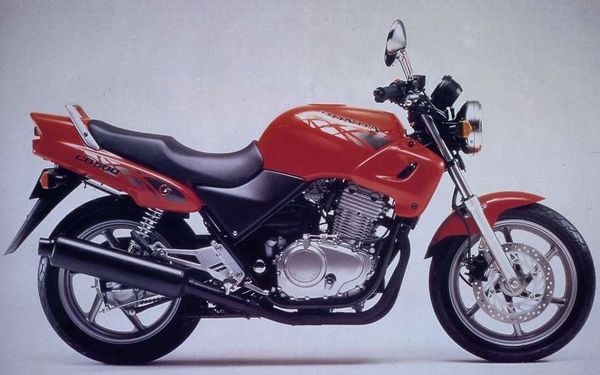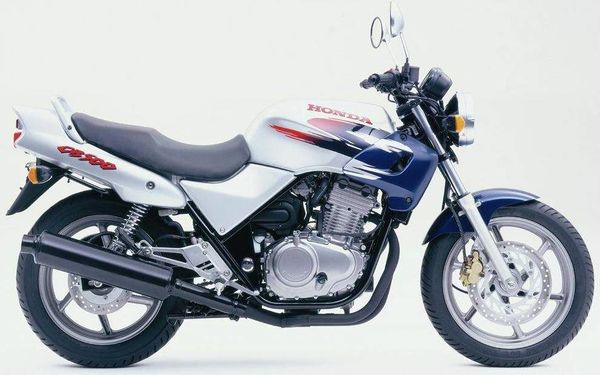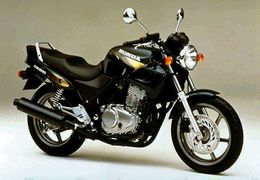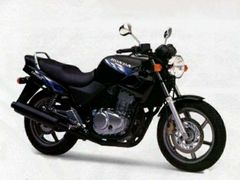Difference between revisions of "Honda CB500E"
(template fixes) |
|||
| Line 5: | Line 5: | ||
|manufacturer = Honda | |manufacturer = Honda | ||
|parent_company = | |parent_company = | ||
|production = 1993 - | |production = 1993 - 2003 | ||
|model_year = | |model_year = | ||
|predecessor = | |predecessor = | ||
| Line 14: | Line 14: | ||
|compression = 10.5:1 | |compression = 10.5:1 | ||
|top_speed = 186.4 km/h / 115.8 mph | |top_speed = 186.4 km/h / 115.8 mph | ||
|power = | |power = 58.07 HP (43.3 KW) @ 9500RPM | ||
|torque = | |torque = 34.67 ft/lbs (47.0 Nm) @ 8000RPM | ||
|fuel_system = | |fuel_system = 2x32mm Keihin carburetors | ||
|ignition = CDI | |ignition = CDI | ||
|spark_plug = | |spark_plug = | ||
| Line 43: | Line 43: | ||
|competition = | |competition = | ||
}} | }} | ||
The '''[[Honda]] CB 500E''' was a liquid-cooled, four-stroke, parallel twin cylinder, DOHC, 4 valves per cylinder Naked [[motorcycle]] produced by [[Honda]] between 1993 and 2003. Max [[torque]] was 34.67 ft/lbs (47.0 Nm) @ 8000 RPM. Claimed [[horsepower]] was 58.07 HP (43.3 KW) @ 9500 RPM. | |||
It could reach a top speed of 186.4 km/h / 115.8 mph. | It could reach a top speed of 186.4 km/h / 115.8 mph. | ||
| Line 51: | Line 51: | ||
==Chassis== | ==Chassis== | ||
It came with a 110/80-17 front [[tire]] and a 130/80-17 rear tire. Stopping was achieved via Single 296mm disc 2 piston caliper in the front and a 160mm Drum in the rear. The front suspension was a 37mm Telescopic forks while the rear was equipped with a Twin shock adjustable.. The CB500E was fitted with a 18 Liters / 4.7 US gal fuel tank. The bike weighed just 170 kg / 374.7 lbs. | It came with a 110/80-17 front [[tire]] and a 130/80-17 rear tire. Stopping was achieved via Single 296mm disc 2 piston caliper in the front and a 160mm Drum in the rear. The front suspension was a 37mm Telescopic forks while the rear was equipped with a Twin shock adjustable.. The CB500E was fitted with a 18 Liters / 4.7 US gal fuel tank. The bike weighed just 170 kg / 374.7 lbs. | ||
==1993 Honda CB 500E== | |||
The 1993 MY Honda CB 500E has, at its heart, a liquid-cooled, four-stroke, 499cc, parallel twin cylinder powerplant that was mated to a six-speed manual transmission with a chain final drive, and can reach a maximum power output of 58 horsepower at 47 Nm of torque. | |||
In addition, it has been fitted with cast-aluminum wheels, an one-piece, two-up seat with a passenger grab handle, a blacked-out, steel frame, a blacked-out exhaust system, a round headlight with a chromed nacelle, a telescopic front fork coupled to dual shock absorbers in the rear, dual front disc brakes, a drum brake in the rear and analogue instrumentation dials. | |||
==1994 Honda CB 500E== | |||
The 1994 MY Honda CB 500E has standard features such as cast-aluminum wheels, an one-piece, two-up seat with a passenger grab handle, a blacked-out, steel frame, a blacked-out exhaust system, a round headlight with a chromed nacelle, a telescopic front fork coupled to dual shock absorbers in the rear, dual front disc brakes, a drum brake in the rear and analogue instrumentation dials. | |||
In the engine department it is powered by an air-cooled, four-stroke, 499cc, parallel twin cylinder powerhouse, paired to a six-speed manual transmission, that can produce a claimed 58 horsepower and 47 Nm of torque. | |||
==1995 Honda CB 500E== | |||
The 1995 MY Honda CB 500E boasts a maximum power output of 58 horsepower and 47 Nm of torque from its air-cooled, four-stroke, 499cc, parallel twin cylinder powerplant that was mated to a five-speed manual transmission with a chain final drive. | |||
In addition, it comes with cast-aluminum wheels, an one-piece, two-up seat with a passenger grab handle, a blacked-out, steel frame, a blacked-out exhaust system, a round headlight with a chromed nacelle, a telescopic front fork coupled to dual shock absorbers in the rear, dual front disc brakes, a drum brake in the rear and analogue instrumentation dials. | |||
==1996 Honda CB 500E== | |||
The Japanese engineers from Honda have launched yet another embodiment of their CB 500E two-wheeler, that has fittings such as cast-aluminum wheels, an one-piece, two-up seat with a passenger grab handle, a blacked-out, steel frame, a blacked-out exhaust system, a round headlight with a chromed nacelle, a telescopic front fork coupled to dual shock absorbers in the rear, dual front disc brakes, a drum brake in the rear and analogue instrumentation dials. | |||
Also, it can produce a claimed 58 horsepower and 47 Nm of torque from its four-stroke, air-cooled, 499cc, parallel twin cylinder powerhouse that was paired to a five-speed manual transmission with a chain final drive. | |||
==1997 Honda CB 500E== | |||
[[File:honda-cb-500e-1997-1997-1.jpg|600px|1997 Honda CB 500E]] | |||
[[File:honda-cb-500e-1997-1997-0.jpg|600px|1997 Honda CB 500E]] | |||
The 1997 MY Honda CB 500E has, at its heart, a liquid-cooled, four-stroke, 499cc, parallel twin cylinder powerplant that was paired to a six-speed manual transmission with a chain final drive, and can reach a maximum power output of 58 horsepower and 47 Nm of torque. | |||
In addition, i has standard features such as dual front disc brakes coupled to a rear drum, a 37mm telescopic front fork, dual adjustable shock absorbers in the rear, a dual seat with a pillion grab handle, a blacked-out exhaust system, cast-aluminum wheels, an analogue instrument cluster and wide handlebars. | |||
==1998 Honda CB 500E== | |||
The 1998 MY Honda CB 500E comes equipped with dual front disc brakes coupled to a rear drum, a 37mm telescopic front fork, dual adjustable shock absorbers in the rear, a dual seat with a pillion grab handle, a blacked-out exhaust system, cast-aluminum wheels, an analogue instrument cluster and wide handlebars. | |||
In the engine department it is powered by a four-stroke, liquid-cooled, 499cc, parallel twin cylinder powerplant, mated to a six-speed manual transmission with a chain final drive, that can produce a claimed 58 horsepower and 47 Nm of torque. | |||
==1999 Honda CB 500E== | |||
The 1999 MY Honda CB 500E boasts a maximum power output of 58 horsepower and 47 Nm of torque from its four-stroke, air-cooled, 499cc, parallel twin cylinder powerhouse that paired to a six-speed manual transmission with a chain final drive. | |||
Standard features for this naked machine include dual front disc brakes coupled to a rear drum, a 37mm telescopic front fork, dual adjustable shock absorbers in the rear, a dual seat with a pillion grab handle, a blacked-out exhaust system, cast-aluminum wheels, an analogue instrument cluster and wide handlebars. | |||
==2000 Honda CB 500E== | |||
The 2000 MY Honda CB 500E has fittings such as dual front disc brakes coupled to a rear drum, a 37mm telescopic front fork, dual adjustable shock absorbers in the rear, a dual seat with a pillion grab handle, a blacked-out exhaust system, cast-aluminum wheels, an analogue instrument cluster and wide handlebars. | |||
This middle-class naked from House Tokyo can also produce a claimed 58 horsepower and 47 Nm of torque from its four-stroke, air-cooled, 499cc, parallel twin cylinder powerplant that was mated to a five-speed manual transmission with a chain final drive. | |||
==2001 Honda CB 500E== | |||
The 2001 MY Honda CB 500E has, at its heart, a four-stroke, liquid-cooled, 499cc, parallel twin cylinder powerhouse, mated to a six-speed manual transmission with a chain final drive, that can reach a maximum power output of 58 horsepower and 47 Nm of torque. | |||
Standard features include a dual seat with a passenger grab handle, cast-aluminum wheels, an analogue instrumentation panel, wide handlebars, dual front disc brakes and a single disc in the rear, a blacked-out exhaust system, a black steel frame, a telescopic front fork and dual shock absorbers as a rear suspension. | |||
==2002 Honda CB 500E== | |||
The 2002 MY Honda CB 500E has been fitted with a dual seat with a passenger grab handle, cast-aluminum wheels, an analogue instrumentation panel, wide handlebars, dual front disc brakes and a single disc in the rear, a blacked-out exhaust system, a black steel frame, a telescopic front fork and dual shock absorbers as a rear suspension. | |||
In the engine department it is powered by a liquid-cooled, four-stroke, 499cc, parallel twin cylinder powerplant that was paired to a six-speed manual transmission with a chain final drive, and can produce a claimed 58 horsepower and 47 Nm of torque. | |||
==2003 Honda CB 500E== | |||
[[File:honda-cb-500e-2003-2003-0.jpg|600px|2003 Honda CB 500E]] | |||
The 2003 MY Honda CB 500E boasts a maximum power output of 58 horsepower and 47 Nm of torque from its liquid-cooled, four-stroke, 499cc, parallel twin cylinder powerhouse that was mated to a six-speed manual transmission with a chain final drive. | |||
Also, it comes with a dual seat with a passenger grab handle, cast-aluminum wheels, an analogue instrumentation panel, wide handlebars, dual front disc brakes and a single disc in the rear, a blacked-out exhaust system, a black steel frame, a telescopic front fork and dual shock absorbers as a rear suspension. | |||
== Photos == | |||
<gallery mode='packed-hover'> | |||
File:Honda-CB500-94--2.jpg|600px|Honda CB500E | |||
File:Honda-CB500-94--1.jpg|600px|Honda CB500E | |||
</gallery> | |||
== Overview == | |||
A JACK of all trades, according to the old adage, is master of none and | A JACK of all trades, according to the old adage, is master of none and | ||
Latest revision as of 14:09, 23 December 2019
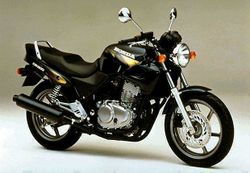 |
|
| Honda CB500E | |
| Manufacturer | |
|---|---|
| Production | 1993 - 2003 |
| Class | Standard |
| Engine | Four stroke, parallel twin cylinder, DOHC, 4 valves per cylinder |
| Compression ratio | 10.5:1 |
| Top Speed | 186.4 km/h / 115.8 mph |
| Horsepower | 58.07 HP (43.3 KW) @ 9500RPM |
| Torque | 34.67 ft/lbs (47.0 Nm) @ 8000RPM |
| Fuel System | 2x32mm Keihin carburetors |
| Ignition | CDI |
| Transmission | 6 Speed |
| Suspension | Front: 37mm Telescopic forks Rear: Twin shock adjustable. |
| Brakes | Front: Single 296mm disc 2 piston caliper Rear: 160mm Drum |
| Front Tire | 110/80-17 |
| Rear Tire | 130/80-17 |
| Seat Height | 775 mm / 30.5 in |
| Weight | 170 kg / 374.7 lbs (dry), |
| Recommended Oil | Honda GN4 10W-40 |
| Fuel Capacity | 18 Liters / 4.7 US gal |
| Manuals | Service Manual |
The Honda CB 500E was a liquid-cooled, four-stroke, parallel twin cylinder, DOHC, 4 valves per cylinder Naked motorcycle produced by Honda between 1993 and 2003. Max torque was 34.67 ft/lbs (47.0 Nm) @ 8000 RPM. Claimed horsepower was 58.07 HP (43.3 KW) @ 9500 RPM. It could reach a top speed of 186.4 km/h / 115.8 mph.
Engine[edit | edit source]
The engine was a Liquid cooled cooled Four stroke, parallel twin cylinder, DOHC, 4 valves per cylinder. The engine featured a 10.5:1 compression ratio.
Chassis[edit | edit source]
It came with a 110/80-17 front tire and a 130/80-17 rear tire. Stopping was achieved via Single 296mm disc 2 piston caliper in the front and a 160mm Drum in the rear. The front suspension was a 37mm Telescopic forks while the rear was equipped with a Twin shock adjustable.. The CB500E was fitted with a 18 Liters / 4.7 US gal fuel tank. The bike weighed just 170 kg / 374.7 lbs.
1993 Honda CB 500E[edit | edit source]
The 1993 MY Honda CB 500E has, at its heart, a liquid-cooled, four-stroke, 499cc, parallel twin cylinder powerplant that was mated to a six-speed manual transmission with a chain final drive, and can reach a maximum power output of 58 horsepower at 47 Nm of torque.
In addition, it has been fitted with cast-aluminum wheels, an one-piece, two-up seat with a passenger grab handle, a blacked-out, steel frame, a blacked-out exhaust system, a round headlight with a chromed nacelle, a telescopic front fork coupled to dual shock absorbers in the rear, dual front disc brakes, a drum brake in the rear and analogue instrumentation dials.
1994 Honda CB 500E[edit | edit source]
The 1994 MY Honda CB 500E has standard features such as cast-aluminum wheels, an one-piece, two-up seat with a passenger grab handle, a blacked-out, steel frame, a blacked-out exhaust system, a round headlight with a chromed nacelle, a telescopic front fork coupled to dual shock absorbers in the rear, dual front disc brakes, a drum brake in the rear and analogue instrumentation dials.
In the engine department it is powered by an air-cooled, four-stroke, 499cc, parallel twin cylinder powerhouse, paired to a six-speed manual transmission, that can produce a claimed 58 horsepower and 47 Nm of torque.
1995 Honda CB 500E[edit | edit source]
The 1995 MY Honda CB 500E boasts a maximum power output of 58 horsepower and 47 Nm of torque from its air-cooled, four-stroke, 499cc, parallel twin cylinder powerplant that was mated to a five-speed manual transmission with a chain final drive.
In addition, it comes with cast-aluminum wheels, an one-piece, two-up seat with a passenger grab handle, a blacked-out, steel frame, a blacked-out exhaust system, a round headlight with a chromed nacelle, a telescopic front fork coupled to dual shock absorbers in the rear, dual front disc brakes, a drum brake in the rear and analogue instrumentation dials.
1996 Honda CB 500E[edit | edit source]
The Japanese engineers from Honda have launched yet another embodiment of their CB 500E two-wheeler, that has fittings such as cast-aluminum wheels, an one-piece, two-up seat with a passenger grab handle, a blacked-out, steel frame, a blacked-out exhaust system, a round headlight with a chromed nacelle, a telescopic front fork coupled to dual shock absorbers in the rear, dual front disc brakes, a drum brake in the rear and analogue instrumentation dials.
Also, it can produce a claimed 58 horsepower and 47 Nm of torque from its four-stroke, air-cooled, 499cc, parallel twin cylinder powerhouse that was paired to a five-speed manual transmission with a chain final drive.
1997 Honda CB 500E[edit | edit source]
The 1997 MY Honda CB 500E has, at its heart, a liquid-cooled, four-stroke, 499cc, parallel twin cylinder powerplant that was paired to a six-speed manual transmission with a chain final drive, and can reach a maximum power output of 58 horsepower and 47 Nm of torque.
In addition, i has standard features such as dual front disc brakes coupled to a rear drum, a 37mm telescopic front fork, dual adjustable shock absorbers in the rear, a dual seat with a pillion grab handle, a blacked-out exhaust system, cast-aluminum wheels, an analogue instrument cluster and wide handlebars.
1998 Honda CB 500E[edit | edit source]
The 1998 MY Honda CB 500E comes equipped with dual front disc brakes coupled to a rear drum, a 37mm telescopic front fork, dual adjustable shock absorbers in the rear, a dual seat with a pillion grab handle, a blacked-out exhaust system, cast-aluminum wheels, an analogue instrument cluster and wide handlebars.
In the engine department it is powered by a four-stroke, liquid-cooled, 499cc, parallel twin cylinder powerplant, mated to a six-speed manual transmission with a chain final drive, that can produce a claimed 58 horsepower and 47 Nm of torque.
1999 Honda CB 500E[edit | edit source]
The 1999 MY Honda CB 500E boasts a maximum power output of 58 horsepower and 47 Nm of torque from its four-stroke, air-cooled, 499cc, parallel twin cylinder powerhouse that paired to a six-speed manual transmission with a chain final drive.
Standard features for this naked machine include dual front disc brakes coupled to a rear drum, a 37mm telescopic front fork, dual adjustable shock absorbers in the rear, a dual seat with a pillion grab handle, a blacked-out exhaust system, cast-aluminum wheels, an analogue instrument cluster and wide handlebars.
2000 Honda CB 500E[edit | edit source]
The 2000 MY Honda CB 500E has fittings such as dual front disc brakes coupled to a rear drum, a 37mm telescopic front fork, dual adjustable shock absorbers in the rear, a dual seat with a pillion grab handle, a blacked-out exhaust system, cast-aluminum wheels, an analogue instrument cluster and wide handlebars.
This middle-class naked from House Tokyo can also produce a claimed 58 horsepower and 47 Nm of torque from its four-stroke, air-cooled, 499cc, parallel twin cylinder powerplant that was mated to a five-speed manual transmission with a chain final drive.
2001 Honda CB 500E[edit | edit source]
The 2001 MY Honda CB 500E has, at its heart, a four-stroke, liquid-cooled, 499cc, parallel twin cylinder powerhouse, mated to a six-speed manual transmission with a chain final drive, that can reach a maximum power output of 58 horsepower and 47 Nm of torque.
Standard features include a dual seat with a passenger grab handle, cast-aluminum wheels, an analogue instrumentation panel, wide handlebars, dual front disc brakes and a single disc in the rear, a blacked-out exhaust system, a black steel frame, a telescopic front fork and dual shock absorbers as a rear suspension.
2002 Honda CB 500E[edit | edit source]
The 2002 MY Honda CB 500E has been fitted with a dual seat with a passenger grab handle, cast-aluminum wheels, an analogue instrumentation panel, wide handlebars, dual front disc brakes and a single disc in the rear, a blacked-out exhaust system, a black steel frame, a telescopic front fork and dual shock absorbers as a rear suspension.
In the engine department it is powered by a liquid-cooled, four-stroke, 499cc, parallel twin cylinder powerplant that was paired to a six-speed manual transmission with a chain final drive, and can produce a claimed 58 horsepower and 47 Nm of torque.
2003 Honda CB 500E[edit | edit source]
The 2003 MY Honda CB 500E boasts a maximum power output of 58 horsepower and 47 Nm of torque from its liquid-cooled, four-stroke, 499cc, parallel twin cylinder powerhouse that was mated to a six-speed manual transmission with a chain final drive.
Also, it comes with a dual seat with a passenger grab handle, cast-aluminum wheels, an analogue instrumentation panel, wide handlebars, dual front disc brakes and a single disc in the rear, a blacked-out exhaust system, a black steel frame, a telescopic front fork and dual shock absorbers as a rear suspension.
Photos[edit | edit source]
Overview[edit | edit source]
A JACK of all trades, according to the old adage, is master of none and Honda's all-new CB500 does nothing to shake the old theory. That said, if a Jack of all trades is what you're into, the CB500 should suit you just fine. It's one of those nicely produced, user friendly, well behaved bikes Honda is so good at turning out. Aimed primarily at new licence holders, but with anyone else who'll buy it in mind, the CB neither threatens to tempt you into behaviour rash enough to lose that crisp licence, nor looks boring enough to be overlooked. Honda's design team have gone for the "muscular" look. Just how successful they've been is a matter of opinion, but when I think muscular I think CB1000, not a middleweight parallel twin producing 58bhp. For new licence holders though, there's enough readily available power to frighten the foolhardy and force lessons by inevitable mistakes, but with a dry weight of just 170kg (3751b), the CB can be pulled out of toe-curling scrapes fairly easily. The all-new ("new generation" in Honda-speak) eight-valve liquid-cooled twin throbs away and makes its two pistons felt with a quick thud-thud when blipping the bike off tickover, but a counter-balance shaft, driven directly off the 180 degree crank, smoothes out vibes as soon as you pull away. Gussets Ease of riding was one of Honda's main design objectives and it's fulfilled the brief comprehensively. The motor pulls strongly from standstill and the claimed 351b.ft of torque is spread pretty evenly through the revs, peaking at a buzzy 8000rpm. Cable-controlled clutch action is light and progressive but the lever, along with the brake lever, is non-adjustable, a pointless economy robbing the bike of a feature which should nowadays be standard. The comfortable seat sits 30in high, which shouldn't split too many trouser gussets. Pottering through town, the twin can be eased down to around 2500rpm in sixth before threatening to shake itself to bits, and accelerates cleanly back up the revs, although it's generally happier kept above three grand. This sometimes means changing down to fifth or even fourth to stay in the really useful power on the high street. Low speed steering is excellent -but deteriorates significantly two-up when the front wheel goes light and the riding position is upright enough to keep weight off your wrists. You lean into the wind enough for legal-limit cruising to be perfectly comfortable.
ST 1100 switchgear is user-friendly and could never reduce even an
entry-level rider in the middle of Spaghetti Junction to a flustered,
button-pressing ball of sweat. Clocks and idiot lights are equally inoffensive,
all moulded into a single module with the temperature gauge incorporated at the
bottom left of the rev counter.
Get out of town and two 34mm flat-slide Keihin carbs (similar to those on the
CBR600 and Fire-Blade) feed the motor freely to give brisk acceleration and
snicking up through the sweet gearbox reveals no nasty clunks or graunches.
The CB pulls up to a comfortable 70-80mph cruising speed surprisingly
quickly, with a noticable but unobtrusive patch of vibes coming in at around
6000rpm (about 75mph in top) and clearing soon after as the motor pulls to the
10,500rpm redline.
The bike should be good for about 110-115mph, and the four gallon (18 litre)
fuel tank should give a range, claims Honda, of about 200 miles, at a fuel
economy of 50mpg. The half-gallon (2.5 litre) reserve is easily found thanks to
one of the slickest petrol taps my fingers have ever had the pleasure to fiddle
with.
What the engine refuses to deliver in top end, the rolling chassis makes up
for on the twisties. The frame is a curious, though successful mix of tubular
and box-section steel. A tubular double-cradle passes beneath the .engine, (the
left cradle splits for easier engine removal) while above, 30mm by 45mm box
section perimeter rails give good rigidity.
The sub-frame is also box section steel, as is the swing-arm, worked by
preload adjustable twin shocks. Forks are 37mm and unadjustable but despite the
traditional set-up handling is positive, predictable and confidence-inspiring.
Charging at bends, the single 296mm front disc with dual piston caliper copes
well despite a slightly vague, spongey feel at the lever and as hero blobs hit
the deck mid-corner there's no sign of protest or panic from either rider or
bike.
Reassuringly, considering Honda's target market, the hero blobs (lean-angle
indicators, or something, in Honda-speak) are the first to touch down and during
the brief test session nothing else came close.
I must admit that seeing the bike shod in Dunlop Arrowmax rubber (110/80-17in
front, 130/80-17in rear) was anything but reassuring -it's a long-standing and
probably undeserved mistrust of the marque with memories of wet-weather
nervousness and all-weather tracking. But Dunlop has given them a new tread
pattern and they held rocksteady all day. It never did rain though. Bridgestone
Exedras will also be fitted as original equipment.
Ease of maintenance was also an objective and Honda seem to have made more
than a token effort at fulfilling the brief. The double overhead camshaft
directly operates a bucket and shim set-up for valve operation with a service
interval of 15,000 miles. The shafts are driven by a central chain which will
cause problems when renewal looms, a side-located chain being far easier to
replace if you insist on the endless variety, although on a smooth, 58bhp motor,
replacing the central chain with a rivet-link item wouldn't be out of the
question, though Honda would never condone such rash action. Primary drive is by
gear.
The airbox sits below the carbs and gives easy access through a panel on the
left hand side to the filter cartridge. The oil filter is the familiar
screw-on/off (read skewer with a screwdriver and stain the road outside your
neighbour's house) cartridge type sitting at the front of the engine just above
the sump. Equally easy to get to are both the oil and cooling system fillers,
neither being hidden behind fixed bodywork. (And it's about the subtlest bit of
liquid cooling I've seen, with finning on the cylinder head and barrel giving a
more familiar and acceptable look to the lump than some retro kettles.) The rear
single leading shoe drum brake is another sensible, low-maintenance option and
provides ample back-up for the front disc.
The ignition key unlocks the seat which then hinges back to reveal a deep
(about 12in) storage box for your chips, lock, waterproofs or whatever with the
toolkit sitting under the rear tailpiece. Removing the seat altogether, should
you wish to lob it over the hedge in a temper, is just a matter of pulling it
free of its rear hinge.
Finish is generally high quality with Honda UK offering Tasmanian Green
Metallic (seen here), Solid Black or Fighting Red paint options - ask for them
by name. Engine casings come in a durable-looking gun metal finish, but the matt
black paint on the exhaust downpipes may not last a British winter after a few
thousand miles of stone chips.
Obvious competitors for the CB are Yamaha's XJ600S Diversion (£3999),
Suzuki's GS500E (£3299) and Kawasaki's GPZ500S (£3740) and KLE500 (£3840). My
guess is it will stand up well in such company and although the price is still
to be released I reckon £
Source Bike Magazine
| Make Model | Honda CB 500E |
|---|---|
| Year | 1993 - 94 |
| Engine Type | Four stroke, parallel twin cylinder, DOHC, 4 valves per cylinder |
| Displacement | 499 cc / 30.4 cu-in |
| Bore X Stroke | 73 x 59 mm |
| Cooling System | Liquid cooled |
| Compression | 10.5:1 |
| Induction | 2X 32mm Keihin CV carburetors |
| Ignition | CDI |
| Starting | Electric |
| Max Power | 58 hp / 42.3 kW @ 9500 rpm |
| Max Torque | 47 Nm / 31.6 lb-ft @ 8000 rpm |
| Transmission | 6 Speed |
| Final Drive | Chan |
| Front Suspension | 37mm Telescopic forks |
| Rear Suspension | Twin shock adjustable. |
| Front Brakes | Single 296mm disc 2 piston caliper |
| Rear Brakes | 160mm Drum |
| Front Tire | 110/80-17 |
| Rear Tire | 130/80-17 |
| Seat Height | 775 mm / 30.5 in |
| Dry Weight | 170 kg / 374.7 lbs |
| Fuel Capacity | 18 Liters / 4.7 US gal |
| Consumption Average | 18.1 km/lit |
| Braking 60 - 0 / 100 - 0 | 12.9 m / 40.2 m |
| Standing ¼ Mile | 13.1 sec / 156.0 km/h |
| Top Speed | 186.4 km/h / 115.8 mph |
| Road Test | Tuttomoto 1994 |
